Museo Salvatore Ferragamo lays bare the house’s artistic inspirations

At different venues in the environs of the Museo Salvatore Ferragamo in the heart of Florence, an exhibition named ‘Across Art and Fashion’ (Tra Arte e Moda), that encompasses clothing, accessories, fabrics, works of art, books, periodicals and photographs, considers the often-discussed relationship between fashion and art.
'In the last 10 years, artists have been reflecting on the commercial aspect more and more', according to Stefania Ricci, director of the Ferragamo Museo. 'And fashion designers are using art more too', she continues, 'in research and inspiration'.
With the weighty backdrop of Florence’s history as a meeting place of artists and incubator of art, it’s only fitting that Salvatore Ferragamo chose Uffizi Gallery, the National Library, Museo Marino Marini and the museum of Textile in Prato as its collaborators. 'In the Renaissance, there was no difference between art and craftsmanship', Ricci remarks, and that’s where Mr Ferragamo, the Florentine shoe designer comes into the picture.
There is no question that he was deeply fascinated by avant-garde art, as much as he was fascinated by the glamourous Hollywood world he equipped with elegant footwear. He collaborated with both Dior and Schiapparelli, and bedecked both Audrey Hepburn and Peggy Guggenheim.
Ferragamo took a great deal of inspiration from the colourful works of Sonia Delaunay and from Kenneth Noland’s circular abstraction, and along these pieces contemporary designers like Yohji Yamamoto and Issey Miyake share the plinths with Yinka Shonibare, a Nigerian artist who uses African waxprint textiles in 19th century silhouettes, and Martin Margiela, Helmut Lang and Gareth Pugh. 'Essentially, they all address the problem of the body', concludes Ricci. As did Salvatore Ferragamo, who produced his best work in the 1920s and 1930s, and who will go down in fashion history as the shoe designer who artfully altered our silhouette from the ground up.
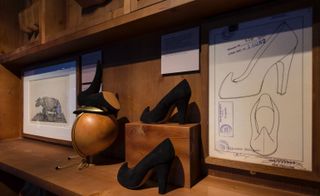
Sketches of one of Ferragamo’s shoes inspired by a rhinocerous’ horn, along with Stephen Jones’ shoe hat
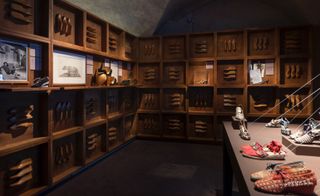
One of the halls showcasing shoes from the collection, including a Peggy Guggenheim inspired shoe, on the far left
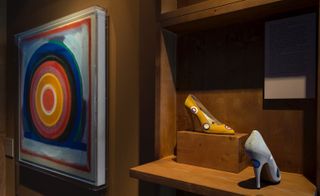
Pictured here, Salvatore Ferragamo’s ’Tirassegno’ suede pump with kid appliqués with a target-shooting motif, and Kenneth Noland’s Untitled painting from 1958, acrylic on canvas, 96 x 96 cm
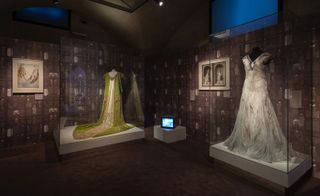
On the left, Rosa Genoni’s ‘Pisanello’ court cape, in silk velvet with embroidery, from 1906
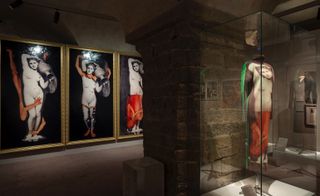
Issey Miyaki’s dress inspired by Yasumasa Morimura’s three-panelled Portrait series, 1986–90
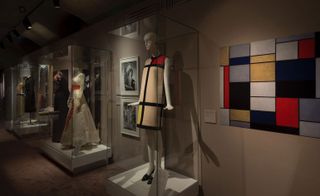
Yves Saint Laurent’s world-famous 1960s Mondrian shift dress, pictured here next to the artist’s painting by which it was inspired
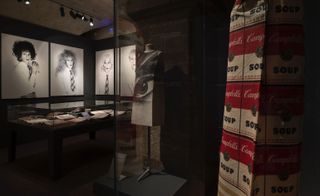
Pictured here, Andy Warhol’s famous The Souper Dress, produced in the Seventies with the motif of the famous Campbell’s Soup can, an image repeated in sequence as silkscreens
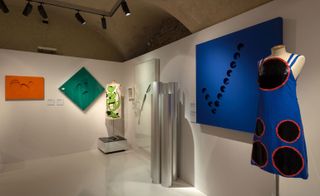
Two dresses by the Italian fashion designer and stylist Germana Marucelli, inspired by the work of Spatialist artist Paolo Scheggi
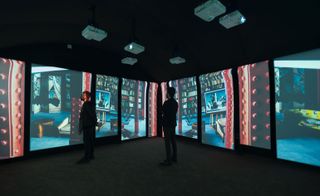
One of the interactive halls in the Ferragamo Museum

Martin Margiela was also one of the designers who was continuously inspired by art and fascinated by the human body, pictured here, some of his famous creations
INFORMATION
'Across Art and Fashion' continues through 7 June 2016. For more information, visit the Museo Salvatore Ferragamo website
Photography: Guglielmo de' Micheli
ADDRESS
Palazzo Spini Feroni, Piazza di Santa Trinita, 5/R, 50123 Firenze, Italy
Wallpaper* Newsletter
Receive our daily digest of inspiration, escapism and design stories from around the world direct to your inbox
Siska Lyssens has contributed to Wallpaper* since 2014, covering design in all its forms – from interiors to architecture and fashion. Now living in the U.S. after spending almost a decade in London, the Belgian journalist puts her creative branding cap on for various clients when not contributing to Wallpaper* or T Magazine.
-
 The moments fashion met art at the 60th Venice Biennale
The moments fashion met art at the 60th Venice BiennaleThe best fashion moments at the 2024 Venice Biennale, with happenings from Dior, Golden Goose, Balenciaga, Burberry and more
By Jack Moss Published
-
 Crispin at Studio Voltaire, in Clapham, is a feast for all the senses
Crispin at Studio Voltaire, in Clapham, is a feast for all the sensesNew restaurant Crispin at Studio Voltaire is the latest opening from the brains behind Bistro Freddie and Bar Crispin, with interiors by Jermaine Gallagher
By Billie Brand Published
-
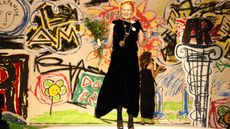 Vivienne Westwood’s personal wardrobe goes up for sale in landmark Christie’s auction
Vivienne Westwood’s personal wardrobe goes up for sale in landmark Christie’s auctionThe proceeds of ’Vivienne Westwood: The Personal Collection’, running this June, will go to the charitable causes she championed during her lifetime
By Jack Moss Published
-
 ‘Shoemaker to the stars’ Salvatore Ferragamo’s colourful life and work celebrated in new exhibition
‘Shoemaker to the stars’ Salvatore Ferragamo’s colourful life and work celebrated in new exhibition‘Salvatore Ferragamo 1898-1960’ at the house’s Florence museum explores the Italian shoe designer’s wide-ranging career, which began in the golden age of Hollywood
By Jack Moss Published
-
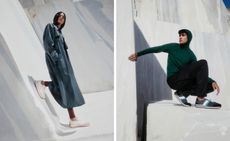 Salvatore Ferragamo’s low-impact sneakers are inspired by vintage running shoes
Salvatore Ferragamo’s low-impact sneakers are inspired by vintage running shoesThe latest arrival from the historic Florentine house is a colourful new series of sneakers, combining vintage inspirations, high-tech materials and sustainable construction
By Jack Moss Last updated
-
 Milan Fashion Week Men’s S/S 2023: Fendi to Prada
Milan Fashion Week Men’s S/S 2023: Fendi to PradaFrom Prada’s exploration of archetypal menswear garments to JW Anderson’s much-anticipated debut in the city, the best of Milan Fashion Week Men’s S/S 2023, as it happens
By Jack Moss Last updated
-
 Milan Fashion Week A/W 2021: designers riff on romp and relaxation
Milan Fashion Week A/W 2021: designers riff on romp and relaxationMilan Fashion Week offered a wardrobe for life after lockdown, by brands including Fendi, Prada, Salvatore Ferragamo, Valentino and Giorgio Armani
By Laura Hawkins Last updated
-
 Sweats and sequins: the duality of dressing at Milan Fashion Week S/S 2021
Sweats and sequins: the duality of dressing at Milan Fashion Week S/S 2021Brands from Dolce & Gabbana to Valentino considered post pandemic dressing, with escapist and pragmatic silhouettes presented with aplomb
By Nick Vinson - Art Direction Last updated
-
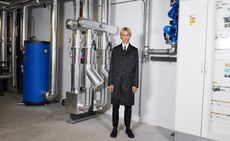 Recapping Milan’s virtual mens fashion week
Recapping Milan’s virtual mens fashion weekThemes of rebirth, re-emergence and reflection embodied the season's multimedia events
By Pei-Ru Keh Last updated
-
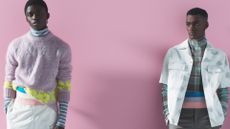 The filmic vision of Paris’ virtual men’s fashion week
The filmic vision of Paris’ virtual men’s fashion weekTake an in-depth look at the trends of Paris' fashion week for Spring/Summer 2021, where brands turned to the moving image to express their collections virtually
By Pei-Ru Keh Last updated
-
 Giorgio Armani A/W 2020 Milan Fashion Week Women's
Giorgio Armani A/W 2020 Milan Fashion Week Women'sBy Laura Hawkins Last updated